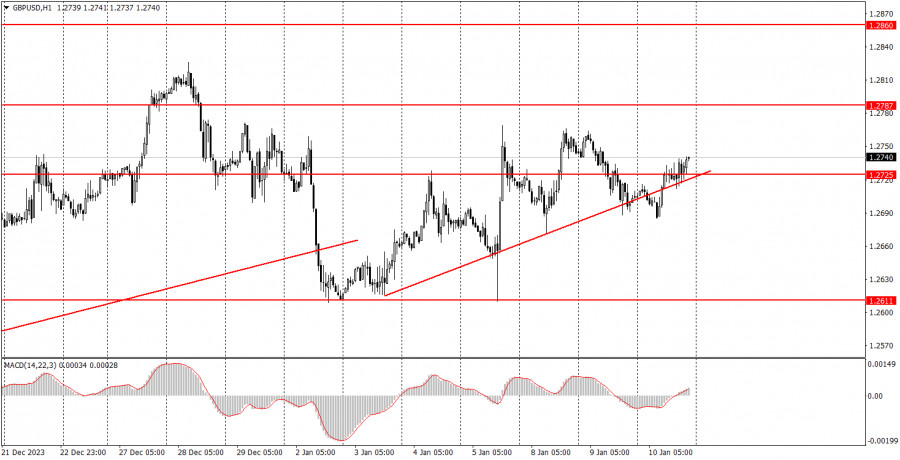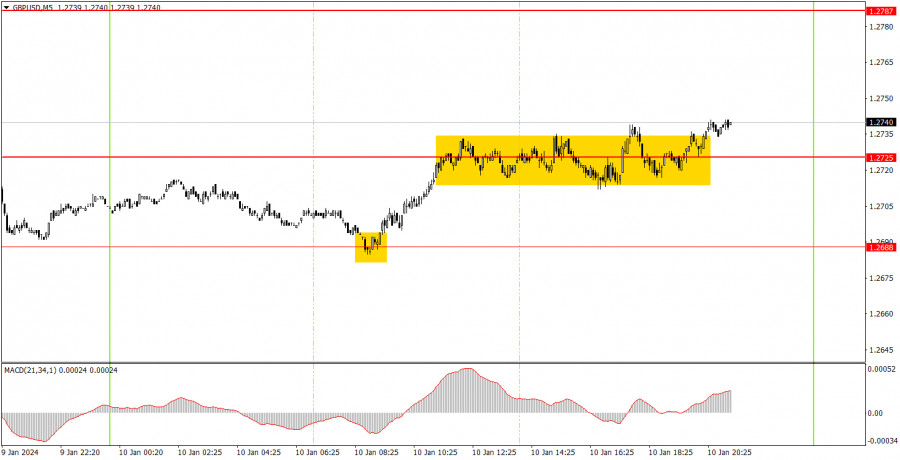

GBP/USD traded higher at the end of Wednesday. Despite breaking the short-term uptrend line, the pound still found a reason to start a new upward movement during the day. However, we have already mentioned that the British currency tends to rise more frequently than the situation, fundamentals, and macroeconomic background requires. We still expect the pound to fall, but the market refuses to sell the pound and buy the dollar. Therefore, many sell signals simply don't work out.
Bank of England Governor Andrew Bailey gave a speech in the UK. Since the pound rose during the day, we can assume that Bailey adhered to a hawkish rhetoric once again. However, the British currency does not currently need the support of news and reports. It remains at its highest level in five months even without them.
The last two trading days of the week are expected to be slightly more interesting, as important reports will be released in both the US and the UK. However, the market continues to seize any opportunity to buy the pound and ignores positive factors for the dollar.
GBP/USD on 5M chart
A good signal was generated on the 5-minute timeframe. The bounce from the level of 1.2688 during the European session can be considered a perfect signal. The price spent about 15 minutes near the level and left no ambiguity. Within two hours, it rose to the nearest target level of 1.2725, where it spent the next six hours. It is not even clear how many signals were formed around the level of 1.2725. These signals can also be considered less than perfect. It was best to close long positions and leave the market as soon as it became clear that the price was simply moving along the level.
Trading tips on Thursday:On the hourly chart, GBP/USD broke the ascending trendline and continued to trade higher. Therefore, the pound continues to rise for no logical reason. We still expect the British currency to fall, but we have to remind you that the market is not inclined to sell the pair and buy the dollar. Therefore, strong US reports may not even help the dollar.
We can expect a downward movement, as the trend line was broken on Wednesday. However, recently, it has become increasingly difficult to expect a downward movement. Over the past three weeks, the price has been in a wide sideways range, showing no desire to drop below the level of 1.2611. Perhaps a surge in US inflation will help the dollar aim for 1.2611 once again?
The key levels on the 5M chart are 1.2270, 1.2310, 1.2372-1.2387, 1.2457, 1.2502, 1.2544, 1.2605-1.2611, 1.2688, 1.2725, 1.2787-1.2791, 1.2848-1.2860, 1.2913, 1.2981-1.2993. The only important report of the day will be US inflation. The secondary report is the US jobless claims. The stronger the latest value deviates from the forecast, the stronger the market reaction will be. However, it may be illogical, as has often been the case lately.
Basic trading rules:1) Signal strength is determined by the time taken for its formation (either a bounce or level breach). A shorter formation time indicates a stronger signal.
2) If two or more trades around a certain level are initiated based on false signals, subsequent signals from that level should be disregarded.
3) In a flat market, any currency pair can produce multiple false signals or none at all. In any case, the flat trend is not the best condition for trading.
4) Trading activities are confined between the onset of the European session and mid-way through the U.S. session, after which all open trades should be manually closed.
5) On the 30-minute timeframe, trades based on MACD signals are only advisable amidst substantial volatility and an established trend, confirmed either by a trendline or trend channel.
6) If two levels lie closely together (ranging from 5 to 15 pips apart), they should be considered as a support or resistance zone.
How to read charts:Support and Resistance price levels can serve as targets when buying or selling. You can place Take Profit levels near them.
Red lines represent channels or trend lines, depicting the current market trend and indicating the preferable trading direction.
The MACD(14,22,3) indicator, encompassing both the histogram and signal line, acts as an auxiliary tool and can also be used as a signal source.
Significant speeches and reports (always noted in the news calendar) can profoundly influence the price dynamics. Hence, trading during their release calls for heightened caution. It may be reasonable to exit the market to prevent abrupt price reversals against the prevailing trend.
Beginners should always remember that not every trade will yield profit. Establishing a clear strategy coupled with sound money management is the cornerstone of sustained trading success.